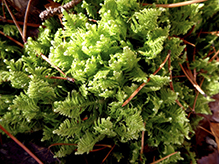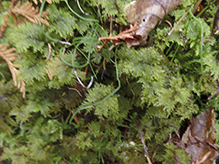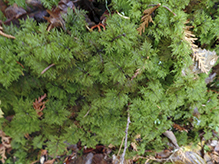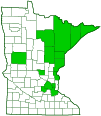brocade moss
(Callicladium imponens)
Conservation • Description • Habitat • Ecology • Use • Distribution • Taxonomy
Conservation Status |
|
|||||||
| IUCN Red List | not listed |
|||||||
| NatureServe | N5 - Secure SNR - Unranked |
|||||||
| Minnesota | not listed |
|||||||
Description |
||
Feather moss is a classification of convenience for identifying certain mosses in the field that have a feather-like appearance. It has no taxonomic equivalent. There are at least seven feather mosses found in Minnesota. Brocade moss is a medium-sized to large, carpet-forming (pleurocarpous), golden-yellow to yellowish-green or brown, feather moss. It occurs in Europe and in North America. In the United States it is common from Maine to Minnesota south to Georgia and Arkansas, and there are scattered records in the west. In Minnesota it is common in the Arrowhead region, infrequent in the Metro area, and absent from the remainder of the state. It grows on the floor of moist forests on soil, soil-covered rocks, logs, and stumps. It often forms dense mats which can cover large areas. The main stem is creeping and lies flat on the ground (prostrate) or nearly so. Erect or almost erect, 1 3 ⁄16″ to 4″ (3 to 10 cm) long branches arise at regular intervals along the main stem, creating a repeating pattern when viewed from above. These branches are reddish-brown and usually regularly pinnately branched, sometimes partially twice pinnate, sometimes irregularly pinnate. These secondary branches (branchlets) are 1 ⁄32″ to 1 ⁄16″ (0.3 to 1.2 mm) long and are arranged in a single plane, giving the branch a flat appearance. The upper half of each leaf is very finely toothed, but this cannot be seen without strong magnification. At the base of each branchlet there is a whorl of tiny, leaf-like, appendages (pseudoparaphyllia). The pseudoparaphyllia are lance-shaped and mostly deeply cut. Stem leaves are shiny, flat, oblong lance-shaped, 1 ⁄16″ (0.8 to 2.0 mm) long, and 1 ⁄32″ (0.6 to 0.8 mm) wide. They have a short, double midrib but this is nearly impossible to see, even with a hand lens. They are swept to one side and strongly curved, like a sickle, the curve often as much as 180°. The leaf tips point downward, toward the substrate. A spore-bearing reproductive structure (sporophyte) rises from the tip of a small branchlet that is well below the tip of a major branch. The sporophyte is a small capsule at the end of a long stalk (seta). The seta is slender, reddish-brown, smooth, and ⅜″ to 1 3 ⁄16″ (1 to 3 cm) long. The capsule is erect or slightly angled, reddish-brown, smooth, and cylinder-shaped. At the end of the capsule there is an obliquely angled opening. When immature the capsule opening (mouth) is covered with a membranous hood (operculum) and a large, smooth cap (calyptra). The operculum is cone-shaped or beak-like. The capsule is 1 ⁄16″ to ⅛″ (1.5 to 3.0 mm) long not including the operculum, and is somewhat curved below the mouth. As it matures, the capsule develops a ring around the opening (annulus). When mature, the annulus forces the operculum and calyptra to drop off exposing the capsule opening. Around the opening there are two sets of teeth. The outer set has 16 yellowish to brownish teeth, each with a distinct zig-zag line. The inner teeth are pale and yellowish. |
||
Growth Form |
||
Pleurocarp |
||
Height |
||
1 3 ⁄16″ to 4″ (3 to 10 cm) |
||
Similar Species |
||
Habitat |
||
Moist. Forest floors. On soil, logs, and soil-covered rocks. Shade. |
||
Ecology |
||
Phenology |
||
Capsules mature July to September |
||
Use |
||
|
||
Distribution |
||||
|
Sources |
|||
| 3/6/2023 | ||||
Nativity |
||||
Native |
||||
Occurrence |
||||
Common in the Arrowhead region |
||||
Taxonomy |
|||
| Kingdom | Plantae (Plants) | ||
| Division | Bryophyta (Mosses) | ||
| Subdivision | Bryophytina (Moss) | ||
| Class | Bryopsida (Joint-toothed Mosses) | ||
| Subclass | Bryidae | ||
Order |
Hypnales (Feather Mosses) | ||
Family |
Hypnaceae | ||
Genus |
Callicladium | ||
Brocade moss was formerly classified as Hypnum imponens. The genus Hypnum was a wastebasket genus, containing basically all creeping, branched, or pleurocarpous mosses, and representing about half of the diversity of mosses. A recent study (Schlesak et al., 2018) used molecular DNA to sort the mosses. Hypnum imponens was transferred to the genus Callicladium. |
|||
Subordinate Taxa |
|||
|
|||
Synonyms |
|||
Hypnum imponens Hypnum cupressiforme var. imponens |
|||
Common Names |
|||
brocade moss hypnum moss |
|||
Glossary
Annulus
On mosses: a ring of cells around the capsule opening beneath the operculum.
Calyptra
On mosses: A thin cap that covers and protects the capsule and operculum and drops off at maturity.
Operculum
On mosses: A lid or cover that covers the opening of a capsule and detaches at maturity.
Pinnate
On a compound leaf, having the leaflets arranged on opposite sides of a common stalk. On a bryophyte, having branches evenly arranged on opposite sides of a stem.
Prostrate
Laying flat on the ground.
Seta
In Lepidoptera: A usually rigid bristle- or hair-like outgrowth used to sense touch. In mosses:The stalk supporting a spore-bearing capsule and supplying it with nutrients. Plural: setae.
Visitor Photos |
|||||
Share your photo of this plant. |
|||||
| This button not working for you? Simply email us at info@MinnesotaSeasons.com. Attach one or more photos and, if you like, a caption. |
|||||
Luciearl |
|||||
 |
 |
||||
 |
|||||
MinnesotaSeasons.com Photos |
|||||
|
|||||

Slideshows |
||

Visitor Videos |
|||
Share your video of this plant. |
|||
| This button not working for you? Simply email us at info@MinnesotaSeasons.com. Attach a video, a YouTube link, or a cloud storage link. |
|||
Other Videos |
|||


Created: 11/15/2019
Last Updated:


